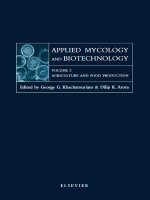Adhesion science and engineering volume 2, the mechanics of adhesion surfaces, chemistry applicat
Bạn đang xem bản rút gọn của tài liệu. Xem và tải ngay bản đầy đủ của tài liệu tại đây (28.82 MB, 1,226 trang )
ADHESION SCIENCE
URFACES,
CHEMISTRY
PLICATIONS
Edited
by
M.
Chaudhary
and
AX
Fb&s
ADHESION SCIENCE AND ENGINEERING
-
2
Series
Editor
A.V.
Pocius
The cover displays a micrograph
of
glass particles on a plasticized polystyrene substrate showing
adhesion-induced viscous flow of the substrate and encapsulation of the particle. The crater
is
the
deformed substrate after a particle had been removed. The micrograph was taken by Ray Bowen
and was supplied by Dr. Donald Rimai.
ADHESION SCIENCE AND ENGINEERING
-
2
SURFACES, CHEMISTRY AND
APPLICATIONS
Edited
by
M.
Chaudhury
Department
of
Chemical Engineering
Center
for
Polymer Inter$aces
Leh igh University
111
Research Drive
Bethlehem, PA
I81
05
U.S.A.
A.V. Pocius
3M
Adhesive Technologies Center
3M
Centei; Building
201
-4N-01
St. Paul,
MN
55144-1000
U.S.A.
2002
ELSEVIER
Amsterdam
-
Boston
-
London
-
New York
-
Oxford
-
Paris
-
San Diego
San
Francisco
-
Singapore
-
Sydney
-
Tokyo
ELSEVIER SCIENCE B.V.
Sara Burgerhartstraat 25
P.O.
Box 211,
1000
AE Amsterdam, The Netherlands
0
2002 Elsevier Science
B.V.
All rights reserved.
This work is protected under copyright by Elsevier Science, and the following terms an,
Photocopying
.onditions apply to its use:
.~
-
Single photocopies of single chapters may be made for personal use as allowed by national copyright laws. Permission
of the Publisher and payment of a fee is required for
all
other photocopying, including multiple or systematic copying,
copying for advertising or promotional purposes, resale, and
all
forms of document delivery. Special rates are available
for educational institutions that wish
to
make photocopies for non-profit educational classroom use.
Permissions may be sought directly from Elsevier Science via their homepage
()
by selecting
‘Customer support’ and then ‘Permissions’. Alternatively you can send
an
e-mail to:
,
or fax
to:
(+44)
I865 853333.
In the
USA,
users may clear permissions and make payments through the Copyright Clearance Center,
Inc.,
222
Rose-
wood Drive, Danvers,
MA
01923,
USA;
phone:
(+I)
(978) 7508400, fax:
(+I)
(978) 7504744, and in the
UK
through
the Copyright Licensing Agency Rapid Clearance Service (CLARCS), 90 Tottenham Court Road, London W
1
P OLP,
UK;
phone: (+44) 207 63
I
5555; fax:
(+44)
207 631 5500. Other countries may have
a
local reprographic rights agency
for payments.
Derivative Works
Tables of contents may be reproduced for internal circulation, but permission of Elsevier Science is required for external
resale or distribution of such material.
Permission of the Publisher is required for all other derivative works, including compilations and translations.
Electronic Storage or Usage
Permission of the Publisher is required to store or use electronically any material contained in this work, including any
chapter or part of
a
chapter.
Except
as
outlined above, no part
of
this work may be reproduced, stored in
a
retrieval system or transmitted in any
form or by any means, electronic, mechanical, photocopying, recording or otherwise, without prior written permission
of the Publisher.
Address permissions requests to: Elsevier Science Global Rights Department, at the fax and e-mail addresses noted
above.
Notice
No
responsibility is assumed by the Publisher for any injury and/or damage to persons or property
as
a
matter of
products liability, negligence or otherwise, or from any nse or operation
of
any methods, products, instructions or
ideas contained in the material herein. Because of rapid advances in the medical sciences, in particular, independent
verification
of
diagnoses and drug dosages should be made.
First
edition 2002
Library
of
Congress Cataloging in Publication Data
A catalog record from the Library of Congress has been applied for.
British Library Cataloguing in Publication Data
A catalogue record from the British Library has been applied for.
ISBN:
0
444
5 1140
7
(set)
8
The paper used in this publication meets the requirements of ANSUNISO
Printed in The Netherlands.
Preface
Volume
I
of Adhesion Science and Engineering dealt with the mechanics of
adhesive bonds and the rheology
of
adhesives. Volume
I1
deals with the other two
disciplines that make up adhesion science, surfaces and chemistry. In addition,
this volume describes several applications of adhesion science and engineering.
The volume begins with discussions of aspects of surface science and how they
relate to adhesion science. Methods based on surface thermodynamics have been
powerful tools in the hands
of
adhesion scientists. Berg introduces us to the topics
of
interfacial thermodynamic and practical adhesion and shows how the critical
predictive parameters of adhesion can be obtained from wetting, solution theory and
group contribution methods (UNIFAC). It becomes clear from Berg’s presentation
that the predictions of adhesion strengths by the traditional wet chemical methods
are somewhat empirical. This limitation can be partially overcome by the methods
of contact mechanics as pioneered by Johnson, Kendall and Roberts, which allows
direct measurements of the surface energies
of
deformable solids. These methods,
as shown by Mangipudi and Falsafi, have played a very important role in developing
a deeper understanding
of
the relationship between adhesion and the chemical
composition of surfaces and complement the chapters describing contact mechanics
found in Volume
I.
Rimai and Quesnel extend this discussion to the interaction
of powdered solids and give us an in-depth view of the types of intermolecular
forces that control adhesion
of
solid surfaces. The chapter by Wahl and Syed Asif
explores the behavior
of
adhesion and contact mechanics at the nanoscopic level.
This
chapter not only complements the above
three
but also describes additional
techniques that may be used
to
probe the properties
of
surfaces. Surface roughness,
which could be examined by some of the probe techniques described in Chapter
4,
is discussed by Packham. Spectroscopic techniques useful for examination of the
chemistry of surface and interfaces are described by Boerio (Chapter
6).
Other aspects of interfacial science and chemistry are examined by Owen and
Wool. The former chapter deals with a widely used chemistry
to
join disparate sur-
faces, that of silane coupling agents. The latter chapter describes the phenomenon
of diffusion at interfaces, which, when it occurs, can yield strong and durable
adhesive bonds. Brown’s chapter describes the micromechanics at the interface
when certain types of diffusive adhesive bonds
are
broken. The section on surfaces
ends with Dillingham’s discussion
of
what can be done to prime surfaces for
adhesive bonding.
The section on chemistry
of
adhesives evolves from rubber-based adhesives to
semi- structural and finally to structural adhesives. Everaerts and Clemens provide
a thorough description of chemistry and applications of pressure sensitive adhe-
sives and Kinning and Schneider describe an enabling technology for pressure
vi
Preface
sensitive adhesive tapes, release coatings. Martin-Martinez reviews the chemistry
and physical properties of rubber-based adhesives with an emphasis on the mate-
rials properties of the components
of
those adhesives. Silicone chemistry provides
products that range from pressure sensitive adhesives to sealants to semi-structural
adhesives and is described by Parbhoo et al. in Chapter 14. Progressing into
more semi-structural and structural adhesives, the chapters by Paul and
by
Frisch
describe the chemistry and properties
of
hot melt adhesives and polyurethane ad-
hesives, respectively. The remainder of this section deals with structural adhesives
beginning with discussions of acrylate chemistry by Righettini and then Klemar-
czyk. The adhesives described in these two chapters are some
of
the most easy
to use structural adhesives available. One of the oldest technologies in modern
adhesive chemistry, phenolic chemistry is described by Detlefson and one of the
newer chemistries, bismaleimides is discussed by Kajiyama.
The final section in this volume deals with applications of adhesion science.
The applications described include methods by which durable adhesive bonds
can be manufactured by the use of appropriate surface preparation (Davis and
Venables) to unique methods for composite repair (Lopata et al.) Adhesive
applications find their way into the generation of wood products (Dunky and
Pizzi) and also find their way into the construction
of
commercial and military
aircraft (Pate). The chapter by Spotnitz et al. shows that adhesion science finds its
way into the life sciences in their discussion of tissue adhesives.
The editors wish to express their sincere thanks to the contributing authors for
their invaluable contributions to this volume. Their collective expertise represents
many years of industrial and academic experience in the field of Adhesion Sci-
ence and Engineering. We would also like to thank the employers of each
of
the
contributors for allowing them to take on the extra tasks associated with the com-
pletion of their contribution to this volume. We would also like to acknowledge
the contribution of Mr. Theodore Reinhart of the University
of
Dayton Research
Center to the initial organization
of
this volume. An unfortunate illness prevented
him from completing his work on this project. Assistance from the Department of
Chemical Engineering and the NSF sponsored IUCRC of the Polymer Interface
Center at Lehigh University are gratefully acknowledged. Finally, we thank our
spouses for their patience as we compiled and edited this volume.
ALPHONSUS V. POCIUS
Editor
Corporate Scientisl
3M Company
St. Paul, MN, USA
MANOJ CHAUDHURY
Associate Editor
Professor of Chemical Engineering
Directol; Center for Polymer Interjkes
Lehigh University
Bethlehem, PA, USA
Contents
Preface
v
Surface
Science
Chapter 1. Semi-empirical strategies for predicting adhesion
J.C.
Berg
1
Chapter
2.
Direct estimation
of
the adhesion
of
solid polymers
KS,
Mangipudi and
A.
Faha$.
75
Chapter
3.
Particle adhesion
D.S.
Rimai and
D.J.
Quesnel
139
Chapter
4.
Surface mechanical measurements at the nanoscale
K.J.
Wahl and
SA.
Syed
Asif.
193
Chapter
5.
Micro-mechanical processes in adhesion and fracture
H.R.
Brown
221
Chapter
6.
Surface analysis in adhesion science
EJ.
Boerio
243
Chapter
7.
Surface roughness and adhesion
D.
E.
Packham.
3
17
Chapter
8.
Diffusion and autohesion
R.P.
Wool
351
Chapter
9.
Coupling agents: chemical bonding at interfaces
M.J.
Owen
403
Chapter 10. Priming to improve adhesion
G.
Uillingham
433
viii
Contents
Chemistry
Chapter
1
1.
Pressure sensitive adhesives
A.I. Everaerts and L.M. Clemens
465
Chapter
Chapter
2.
Release coatings for pressure sensitive adhesives
D.
J.
Kinning and H.M. Schneider
535
3. Rubber base adhesives
J.M. Martin-Martinez
573
Chapter 14. Fundamental aspects
of
adhesion technology in silicones
B.
Parbhoo, L A. O’Hare and
S.R.
Leadley
677
Chapter 15. Hot melt adhesives
C.W
Paul
711
Chapter
16.
Chemistry and technology
of
polyurethane adhesives
K.C. Frisch, Jr.
759
Chapter 17. The chemistry
of
bis-maleimides used in adhesives
M. Kajiyama
813
Chapter
18.
Structural acrylics
R.E Righettini
823
Chapter 19. Cyanoacrylate instant adhesives
P.
Klemarczyk
847
Chapter 20. Phenolic resins: some chemistry, technology, and history
WD.
Detlefsen
869
Applications
Chapter 21. Surface treatments of metal adherends
G.D. Davis and J.D. Venables
947
Chapter 22. Electron beam processed adhesives and their use in composite
repair
VJ. Lopata, A. Puzianowski and M.A. Johnson
1009
Contents
ix
Chapter 23
.
Wood adhesives
M
.
Dunky and A
.
Pizzi
1039
Chapter 24
.
Tissue adhesives and hemostats: new tools for the surgeon
WD
.
Spotnitz. D
.
Mercer and
S
.
Burks
1105
Chapter 25
.
Applications
of
adhesives in aerospace
K.D. Pate
1129
Author Index
1193
Subject Index
1195
Chapter
1
Semi-empirical strategies for predicting
adhesion
JOHN
C.
BERG‘
Department
of
Chemical Engineering, University
of
Washington, Seattle, WA
98105-1
750,
USA
1.
Predicting adhesion: is it a reasonable objective?
1.1.
The scope
of
the question
1.1.1.
The meaning of adhesion, adhesive failure arid iriterjkiul strength
Adhesion refers to a complicated set of inter-connected phenomena that is far from
completely understood, and it therefore makes sense at the outset to inquire into
the reasonableness of any attempts to ‘predict’ it using semi-empirical methods.
To
preserve the hope of
a
positive answer,
it
is first necessary to narrow the scope
of the question. There may be ambiguity with respect to what is to be predicted. It
may refer, on one hand, to the strength
of
an isolated adhesive joint as determined
by some carefully crafted mechanical test in which the joint is destroyed, or it
may, on the other hand, refer to the strength
of
a more complex global structure,
such as a multi-layer laminate, or a fiber-reinforced or particle-filled composite.
The present chapter focuses mainly on the individual adhesive joint rather than
on
global structures in which interfaces exist. Even when attention is focused on
single joints, it must be noted that these may be stressed to failure in different
modes and at different rates, leading to different results. In fact, understanding of
the different interfacial rate processes involved in adhesion is just beginning to
emerge
[I].
Another distinction to be made
is
illustrated with the peel test shown in Fig.
1.
Application
of
stress may cause the joint to fail either ‘adhesively’ or ‘cohesively’.
Adhesive failure, shown in Fig.
la,
is
thought ideally to correspond to a perfect
*
Corresponding author.
E-mail:
berg @cheme.washington.edu
2
J.C. Berg
/
A
adhesive
failure
cohesive
failure
(4
(b)
Fig.
1.
(a) Adhesive
vs.
cohesive failure. (b) Close-up view of adhesive failure in the presence of
an
‘interphase.’ The locus of failure may be adjacent
to
or
within the interphase (as shown), and
particles of material may
be
ejected during the debonding process.
separation
of
the
two
phases meeting at the interface. Sharpe
[2]
has argued
persuasively, however, that such ‘adhesive’ or ‘interfacial’ failure almost never
occurs in practice. Owing to the geometric complexity of any real interface at the
microscopic level, it would be highly unlikely for the system to disjoin precisely
along its contours. One would expect instead to find at least fragments
of
the
opposing material on each of the separated surfaces, and indeed some
of
the
material may be ejected and lost as microparticles during the disjoining process
[3].
Furthermore, Sharpe argues that true interfaces, in the mathematical sense,
dividing phases which are homogeneous right up to the interfaces, almost never
Semi-empirical strategies
for
predicting adhesion
3
exist between joined solid phases. Instead there is generally a transition zone
of finite thickness, perhaps as thin as
1
nm, but possibly as thick as several
micrometers, separating the bulk phases. Called
interphases,
they may be caused
by the interdiffusion or interdigitation
of
the materials, or they may be simply
the result of structuring of the adhesive layer adjacent to the interface due to the
asymmetric molecular forces existing at the boundary between the phases. Such
an ‘interphase’ has a structure, and possibly a composition, distinct from that
of
either of the bulk phases. Recognizing the ubiquitous presence of interphases, the
following definition of terms will be used in this chapter: when the locus of failure
occurs within or immediately adjacent to the interphase, it will be referred to as
‘adhesive’ or ‘interfacial’ failure, as shown in Fig. lb. The word ‘interface’ is thus
used loosely in that it may be referring to an interphase. When failure of the joint
occurs in material outside the interphase, i.e. in one of the bulk phases, it will
be designated as ‘cohesive’ failure. Even with this distinction having been made,
some cases involve a mixture of adhesive and cohesive failure. The design or
choice of a structural adhesive thus may depend on both high interfacial strength
and high cohesive strength of the adhesive. The present chapter concerns adhesive
failure, and therefore focuses on ‘interfacial strength’ in accord with the above
definition.
It must also be recognized that adhesive interfaces are not static entities, but
may deteriorate or even strengthen over time, and often it is the time course
of interfacial strength or durability under different conditions and in different
environments that
is
of
greatest concern
[4].
As
important as durability issues are,
they too will not be a direct concern of this chapter.
It
remains to be determined if even the more modest scope suggested above may
profitably be pursued. To address this question, we note that ‘adhesive interfaces’
refer to those dividing solid phases across which intermolecular forces are engaged
over all
or
a significant portion of the interfacial area. With the exception of clean,
atomically smooth solid surfaces (as might be obtained when Moscovite mica is
freshly cleaved in vacuo), this cannot be achieved by simply bringing two solid
surfaces together. Their inherent roughness and contaminability prevent it. Thus
at least one of the phases must be a liquid (or a polymer sufficiently above its
glass transition temperature to be fluid-like) when the two materials are brought
together to form the interface. The ‘liquid’ phase is designated as the
adhesive,
and the solid surface to which it is applied
is
the
adherend.
The adhesive interface
is finally formed when the adhesive ‘cures’. In most cases, curing results in
solidification
of
the adhesive, although pressure sensitive adhesives may remain
in a viscoelastic state. In most cases, solidification results in the development
of
significant internal residual stresses at the interface owing to the mismatch in
thermo-mechanical properties of the adhesive and adherend
[5,6].
In some cases,
these are great enough to cause interfacial failure without the application of any
external stress at all. In any event, the presence and magnitude
of
internal residual
4
J.C.
Berg
stresses must be taken into account in the analysis
of
the results of mechanical
measurements of interfacial strength. Residual stresses do not directly influence
the
intrinsic
interfacial strength, but instead contribute to the total of the stresses
existing at an interface in a mechanical test.
In a mechanical test, interfacial strength may be quantified in terms of either the
minimum load required for interface disruption or the total integral energy or work
expended. In many situations, due to non-uniformity of chemical or morphological
conditions over the area of the interface or to non-uniformity of the applied stress
in a given test
[7],
the two criteria are different. The investigator must thus strive to
minimize or deal with both of the above complications, i.e. the interfaces studied
should be chemically and morphologically uniform, and the stresses applied in the
test should be uniform or distributed in way which is quantitatively describable.
1.1.2.
Optimizing adhesion
The adhesion scientist or technologist has two general variables at his or her
disposal in seeking to increase or control adhesive interfacial strength:
(1)
the
chemical formulation of the adhesive; and
(2)
the chemistry and morphology of
the adherend surface. The adhesive may be chosen, for example, to be made up of
species capable only
of
Lifshitz-van der Waals (LW) intermolecular interactions
(referring to predominantly dispersion or London’s forces, but also including a
possible small contribution to permanent dipole interactions), or it may be made
to be acidic or basic, or acid-base bifunctional,
or
it may be designed to interact
covalently with the adherend (reactive adhesion). Its surface tension may be
lowered or its viscosity altered through the use
of
additives. Most adhesives are
polymeric, and for a given chemistry of the repeat unit, the molecular weight
and the structure (linear vs. branched, etc.) may be important. Thermosetting
adhesives (e.g. epoxies, polyurethanes, bis-maleimides, etc.) are designed to
crosslink internally, leading to enhanced cohesive strength (outside the scope of
the present discussion), but may also produce covalent bonding with the adherend
across
the interface
[8].
The morphology of the adherend surface may be altered
by roughening or texturizing
(e.g.
acid-etching, grit-blasting, anodization, etc.),
and its chemistry may be altered through plasma treatment, corona treatment,
etc. or the use of finishes, conversion coatings, primers or coupling agents, either
physically adsorbed, coated onto or covalently bonded to the surface.
It is only in the context of the systematic variation of the properties of the
adhesive and/or the adherend surface in
a
set of otherwise identical specimens
subjected to a given mechanical testing procedure that it is reasonable to think of
predicting
relative
interfacial strength.
In the above narrowed context, ‘prediction’ refers to the development of system
descriptors which can be measured independently in some rather simple and
inexpensive way (in terms of time and instrumentation), or
it
may refer
to
ab
Semi-empirical strategies for predicting adhesion
5
initio calculations based on readily available handbook data and requiring no
experimental measurements at all. Both approaches are examined in this chapter.
The objective may be to screen candidate adhesive formulations and/or adherend
surface treatments for the purpose
of
eliminating unpromising candidates for what
is generally tedious and costly mechanical testing. The results of such attempts
may vary from the formulation of simplistic, but nonetheless useful, ‘rules of
thumb’, to more sophisticated optimization schemes. Such guidelines may be
useful even when all
of
the above-mentioned
caveats
are not observed.
1.2.
‘Practical’
vs.
‘ideal’ adhesion
I
.2.
I.
Practical adhesion
The measure of adhesive interfacial strength is the result of a properly conducted
mechanical test which leads to a predominantly adhesive failure of the specimen.
This leads to a measure of what is termed ‘mechanical’, or ‘practical’ adhesion.
Many different such tests are described in detail elsewhere in this text series, as
well as in standard texts on adhesion
[9-111.
As
noted above, however, even for
a
given material interface, different tests carried out under the same thermodynamic
conditions, or the same test carried out at different rates (normalized in accord
with
WLF
theory, described elsewhere in this text series), will in general lead to
different values for the failure stress or for the energy per unit area required to
disjoin the interface. The recent emergence of the method of ‘contact mechanics’,
reviewed recently by Chaudhury
[
121, permits the quantitative mechanical deter-
mination, under idealized circumstances, of both the energy required to separate
t
:o
surfaces
as
well as the energy gained by adjoining them, and the results
indicate that there is a sizable difference between the two (‘adhesion hysteresis’)
[I
31.
Thus any valid comparisons of practical adhesion between material systems
whose properties are varied as suggested above must pertain to the same test,
carried out under the same conditions at the same normalized rate. Even when
these requirements are stringently met, the results may show significant variation,
as
has
been demonstrated in a round-robin program in
1993
involving
12
differ-
ent laboratories measuring the interfacial shear strength of the same fiber/matrix
interface with the same set
of
techniques [14]. Fig. 2 shows the results of this
effort, revealing variations within any given test method of approximately a factor
of two amongst the different laboratories. Thus the objective of predictions
must
be recognized as a somewhat blurred target, although it may be hoped that results
for practical adhesion obtained in any given laboratory for a series
of
properly
conducted tests may be validly compared.
6
120.0
100.0
80.0
60.0
40.0
20.0
0.0
J.C.
Berg
IIIIIIIIIII
-
-
-
-
-
Fragmentation
-
-
Indentation
-
-
-
Am
-
A
-
-
**
-
-
A
-
-
A
0.
-
-
0
4)
11111111111
0
-
-
h
B
n
W
Fragmentation
Indentation
80.0
2
,;I,,
I,
I
I
c(
.d
cd
%
8
4
0.0
0
12
3
4
5
6
7
8
9101112
Laboratory
co)
Fig.
2.
Results
of
interfacial shear strength measurements
of
the same fiberlmatrix systems
using four different micro-mechanical tests during a round-robin program involving
12
different
laboratories. (a) Results for untreated, unsized carbon fibers.
(b)
Results for carbon fibers with the
standard level
of
surface treatment. Redrawn from ref. [13].
1.2.2.
Ideal adhesion
Most
of
the various strategies which have been proposed
to
‘predict’ relative
adhesive interfacial strength are based on thermodynamics. One may define,
without ambiguity, as shown in Fig.
3,
a thermodynamic
‘work
of
adhesion’,
W,,
Semi-empirical strategies
for
predicting adhesion
7
W,
=
reversible work
=
Ys
+
"h
-
YSL
-
vacuum
S
(adherend)
interface
of
unit area
WA
=
YSm
+
It"
-
YSL
fluid
medium m
W,
=
ys
+
yL
-
ysL
-
'IC,
>
air
+
vapors
of
adhesive
(c)
Fig.
3.
Definition
of
thermodynamic work
of
adhesion,
WA:
(a) disjoining surfaces in vacuum;
(b)
disjoining surfaces in fluid medium m; and (c) disjoining surfaces in presence
of
vapors
from
adhesive.
as the reversible work required to perfectly disjoin a unit area of interface between
an adherend
S
(solid) and adhesive
L
(liquid) in some fluid medium
m,
as given by
the Dupr6 equation:
where
yr
is the surface or interfacial tension of the adhesive (liquid) in the fluid
medium m.
Y,"
is the interfacial free energy/area
of
the adherend (solid)/medium
8
J.C.
Berg
interface, and
ys~
is the interfacial free energy /area of the adhesive/adherend
interface.
WA
is thus the free energy/area of the surfaces created minus that of the
interface destroyed in the disjoining event. This is equivalent to the negative free
energy change associated with the contacting event, that is,
WA
=
-AGEadheaion.
It
is seen to depend not only upon the adhesive and the adherend, but also upon the
fluid medium in which the system resides. It is usually assumed that this medium
is air, whose components are assumed to adsorb but negligibly on the surfaces of
either the adhesive or the adherend. While this is generally true, complications
arise when the air contains water vapor or when the adhesive is volatile, and
its vapors adsorb onto the otherwise dry adherend. Water vapor may adsorb to
the adherend surface reducing its energy,
so
that any accounting of such energy
must take this into consideration. Any adsorption of vapors from the adhesive also
reduces the surface energy of the adsorbent, by an amount at equilibrium termed
the equilibrium spreading pressure,
ne,
so
that the Dupr6 equation becomes:
(2)
It is common to neglect the effect of equilibrium spreading pressure, particularly
for ‘low surface energy’ adsorbents
[15,16],
but there is some evidence that it
may not be negligible even under such circumstances
[17,18].
It can certainly
be neglected for polymeric liquids, owing to their non-volatility. Whether
ne
is
taken into account or not, the work of adhesion is thought to be a measure of the
‘thermodynamic’ or ‘ideal’ adhesion for a given adhesive/adherend system. One
must next inquire:
(1)
whether
WA
is conveniently measured; and
(2)
if it relates
in any meaningful way to practical adhesion, defined earlier.
While the surface tension of the adhesive,
n,
is easily measured in the
laboratory, the other terms in
WA,
by themselves, are not.
A
second easily
measurable property associated with the solid-liquid-air system, however, is the
contact angle,
8,
the angle, drawn in the liquid, between the solid-liquid and the
liquid-air interfaces, drawn in the plane perpendicular to the three-phase interline,
as shown in Fig.
4.
Minimization of the free energy of the solid-liquid-air
WA
=
)/s
+
YL
-
YSL
-
ne.
Fig.
4.
Definition of contact angle showing the derivation of Young’s equation,
Eq.
3,
using a
balance of horizontal forces at the three-phase interline.
Semi-empiricul strategies
for
predicting adhesion
9
system with respect to
0
leads to a relationship between the contact angle and the
free energies
of
the interfaces meeting at the three-phase interline, viz. Young's
equation:
(3)
Eq.
3
may also be derived heuristically by making a balance of horizontal forces
on a small section of the interline as shown in Fig.
4.
This treats the solid surface
and the solid-liquid interface as though they were in states of tension given by
their respective surface energies. The vertical force
n
sin0 in such a construction
is balanced by stresses in the underlying solid.
If equilibrium spreading pressure is to be included,
it
must be subtracted from
the right hand side of Eq.
3,
i.e.
YS
-
YSL
n
Ys
-
YSL
n
cos0
=
(34
Since
-1
<
cos0
<
1,
Young's equation is valid only when the right hand side of
Erl
3
or Eq. 3a lies between these limits, i.e. the observed contact angle is finite.
In
le
event that the measured contact angle is
O",
i.e. full spreading occurs, one
may conclude only that
cos0
=
-Ire.
Ys
-
YSL
Ys
-
YSL
or
-ne>l
M.
VL
(4)
Substitution of Eq.
3
into
Eq.
1
leads to the Young-DuprC equation:
w,
=
n(1
+cos@,
(5)
which suggests that thermodynamic adhesion is quantifiable in terms of the readily
measured values of
VL
and
0,
at least for the situation in which the contact angle is
finite.
The technique of contact mechanics has also been applied to the direct me-
chanical determination of solid-fluid interfacial energies, and the results compare
favorably with those obtained by contact angle measurements
[
191.
If equilibrium spreading pressure is to be accounted for, it is added to the right
hand side of Eq.
5,
giving:
w,
=
n(l
+cosO)+ne.
(54
Determination
of
the equilibrium spreading pressure generally requires measure-
ment and integration of the adsorption isotherm for the adhesive vapors
on
the
adherend from zero coverage to saturation, in accord with the Gibbs adsorption
equation
[2O]:
0
10
J.C.
Berg
where r(p) is the adsorbed amount (moles/area) as a function of the adsorbate
partial pressure,
p,
and
ps
is the saturation value. The needed data are not
so
easily obtained as those of contact angle and surface tension. A second difficulty
with using the Young-Dupr6 equation to estimate the work of adhesion is that it
presumes the use of an appropriate stable
equilibrium
contact angle.
In
practice,
one measures either an advancing angle or a receding angle, and the hysteresis
between them is significant. Both refer to metastable states
[21].
It is common
practice to use the static advanced angle to compute the work of adhesion, but this
cannot be rigorously justified.
One may also be able to determine the work of adhesion for cases in which
the contact angle is zero by using
probe liquids,
as described later in this chapter.
There are also other ways
of
determining the work of adhesion, such as inverse gas
chromatography, which
do
not depend solely on capillary measurements (surface
tension and contact angle). This too will be discussed later.
1.2.3.
The relationship between practical adhesion and the work
of
adhesion,
W,
Assuming the work of adhesion to be measurable, one must next ask
if
it can be
related to practical adhesion.
If
so,
it may be a useful predictor of adhesion. The
prospect at first looks bleak. The perfect disjoining
of
phases contemplated by
Eq.
1
almost never occurs, and
it
takes
no
account
of
the existence of an ‘interphase’,
as discussed earlier. Nonetheless, modeling the complex real interphase as a true
mathematical interface has led to quantitative relationships between mechanical
quantities and the work of adhesion. For example, Cox
[22]
suggested a linear
relationship between
WA
and the interfacial shear strength,
t,
in a fiber-matrix
composite as follows:
where
E,
and
Ef
are the elastic moduli of the matrix and the fiber, respectively,
and
h
is
a universal length
(~0.5
nm). This has led to a number of successful
interpretations of fiber fragmentation tests
on
these types
of
systems described
later.
The most-often cited theoretical underpinning for a relationship between prac-
tical adhesion energy and the work of adhesion is the generalized fracture me-
chanics theory of Gent and coworkers
[23-251
and contributed to by Andrews and
Kinloch
[26-291.
This defines a linear relationship between the mechanical work
of separation,
w,,
and the thermodynamic work of adhesion:
wm
=
C(b,T,&)’wA,
(8)
where
w,
is the work of separation (per unit area) and
C
is the mechanical loss
factor, which accounts for the effects of geometry and rheology, and depends on
Semi-empirical strategies for predicting adhesion
11
the crack growth rate
(a),
temperature
(T)
and maximum strain level
(E).
The
theory was developed for elastic adhesives against hard (brittle) solid adherends,
and is limited to slow (quasi-equilibrium) rates of detachment
[7].
The format
of Eq.
8
has been corroborated with experiments in which only the work
of
adhesion factor was changed. For example, Gent and Schultz
[25]
measured the
peel strength of a polybutadiene film on Mylar under a variety of solvent media
(air, water, butanol, etc.) and found it to vary in proportion to the work
of
adhesion
as computed using Eq. 1 with contact angle values evaluated in the solvent media.
Similar results have been found more recently for cases involving acid-base
effects [30].
Combination of Eq.
7
or Eq.
8
with the Young-Dupr6 equation, Eq.
3,
suggests
that the mechanical work of separation (and perhaps also the mechanical adhesive
interface strength) should be proportional to
(1
+
cos6') in any series
of
tests
where other factors are kept constant, and in which the contact angle is finite.
This has indeed often been found to be the case, as documented in an extensive
review by Mittal [31], from which a few results are shown in Fig.
5.
Other
important studies have also shown a direct relationship between practical and
thermodynamic adhesion, but a discussion of these will be deferred until later.
It would appear that a useful criterion for maximizing practical adhesion would
be the maximization of the thermodynamic work of adhesion, but this turns
out to be a serious over-simplification. There are numerous instances in which
practical adhesion is found not to correlate with the work of adhesion at all, and
sometimes to correlate
inversely
with it. There are various explanations for such
discrepancies, as discussed below.
1.3.
The mechanisms
of
adhesion
The above discussion has tacitly assumed that it is only molecular interactions
which lead to adhesion, and these have been assumed to occur across relatively
smooth interfaces between materials in intimate contact. As described in typical
textbooks, however, there are a number of disparate mechanisms that may be
responsible for adhesion [9-11,321. The list includes:
(1)
the adsorption mecha-
nism;
(2)
the diffusion mechanism; (3) the mechanical interlocking mechanism;
and
(4)
the electrostatic mechanism. These are pictured schematically in Fig.
6
and
described briefly below, because the various semi-empirical prediction schemes
apply differently depending on which mechanisms are relevant in a given case.
Any given real case often entails a combination
of
mechanisms.
1.3.1.
Adsorption mechanism (contact adhesion)
In
the adsorption mechanism, adhesion is modeled as occurring across a well-
defined interface by molecular interaction across that interface, and is often
12
20
Adhesive
Strength
10
(
kg/cm2)
J.C.
Berg
-
I
I
I
1
2
i+cos
e
Or,
300r
200
-
Bond
Strensth
(psi
(b>
0
1.810 1.850 1.890
1.930
I
I
I
I+COS
e
Fig.
5.
Examples of the correlation between measured adhesive strength and
(1
+cos@). (a)
Plot
of data from Raraty and Tabor
[171]
for adhesion of ice to various solids.
(b)
Plot
of
data of Barbaris
[172]
for adhesion of a mixture of epoxy and polyamide resin to low density
poly(ethy1ene) treated in various ways. Both figures from ref.
[31],
by permission.
referred to as ‘contact adhesion’. Because of the rather short-range nature of
molecular interactions, they occur principally between the outermost molecular
layers of the adherend and the molecules of the adhesive immediately adjacent to
them and are said to be ‘adsorbed’ to the adherend surface. Such adsorption may
be purely physical (physisorption), or it may involve the formation of covalent
bonds across the interface (chemisorption). The mobile molecules or chains
of the adhesive will orient themselves at the interface to maximize whatever
interactions
are
possible and thereby minimize the free energy
of
the system.
The types of interactions may be classified as follows. Lifshitz-van der Waals









